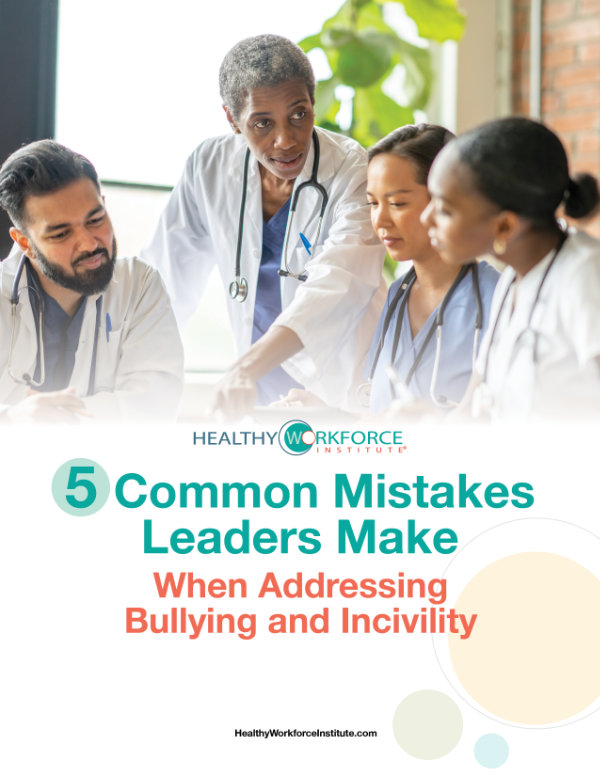 Chances are you’ve heard the saying: People don’t leave jobs; they leave toxic work cultures or People leave managers, not companies. It’s the truth! No one wants to work in a culture that’s negative or worse – toxic. Especially when employees watch their leader doing nothing to address the disruptive behaviors, and where they do not feel valued. Yet, a positive organizational culture has a strong correlation directly impacting turnover, productivity, work satisfaction, and patient outcomes.
Chances are you’ve heard the saying: People don’t leave jobs; they leave toxic work cultures or People leave managers, not companies. It’s the truth! No one wants to work in a culture that’s negative or worse – toxic. Especially when employees watch their leader doing nothing to address the disruptive behaviors, and where they do not feel valued. Yet, a positive organizational culture has a strong correlation directly impacting turnover, productivity, work satisfaction, and patient outcomes.
Yet, culture isn’t always a priority in healthcare – but it should be.
When you walk into a business or hospital unit, the energy from a negative culture is palpable immediately when you walk in the door. You immediately observe no one smiling, laughing, or engaging with one another. You hear the gossip from the employees complaining about their peers or leader. You may observe total silence amongst the team being they are so disengaged. A New York Chef shared that you could taste incivility in his food, and he works hard to eliminate it. Shouldn’t we be doing the same in healthcare?
Has workplace culture gotten worse over the last few years?
In the news and business journals, leaders in every industry share how challenging the work culture is from just a few years ago. Why? As a society over the past two years, we have felt a great disruption within our families, friendships, and workplaces. We have experienced a rollercoaster of emotions such as loss, burn-out, financial instability, disengagement, suffering, and anxiety. In 2015, Dr. Maya Angelou may not have thought about the workforce when she Tweeted this quote, however, it shares the sentiment of today’s workforce:
My mission in life is not merely to survive, but to thrive; and to do so with some passion, some compassion, some humor, and some style.
Organizational psychologists are urging leaders to modify the way they lead their teams and to seek new strategies to foster positive organizational cultures to engage and retain their workforce.
How does organizational culture impact healthcare?
Higher acuity crisis, elevated nurse-to-patient ratios, high census, negative patient outcomes, poor leadership, and a toxic organizational culture are just a few reasons why nurses are leaving the acute care environments at alarming rates.
- Gallup’s recent research indicates 42% of the people resigning from the workplace are due to their leaders and the organization’s culture.
- A recent study reveals a toxic culture is 10 times more likely the cause for employee turnover.
- The 2022 NSI National Health Care Retention & RN Staffing Report, indicates the hospital turnover rate in 2021 at 25.9% which is a 6.4% increase from the 2020.
- And the 2022 NSI report also states the average RN turnover rate is 27.1%; and 27.7% for new graduate nurses within the first year of practice.
Creating a Positive Organizational Culture – The Greatest Challenge
The Healthy Workforce Institute surveyed 295 frontline leaders between June 2021 – February 2022. The purpose of the survey was to gather data from the leaders to identify their greatest challenges, their goals, what might prevent them from achieving their goals, and their vision for their department’s culture in one year.
Organizational culture (69%; n = 203) was the number one theme the respondents indicated as their greatest challenge, top goal, vision for the next year, and would preclude them from achieving their goal. The leaders stated disruptive behaviors between team members and the interprofessional team, a lack of teamwork and collaboration, and a lack of support from upper leadership to hold employees accountable as their major obstacles.
Communication was their second greatest challenge (22%; n = 66), specifically their lack of knowledge on how to have crucial conversations and the lack of confidence to address individuals with disruptive behaviors. Numerous leaders surveyed acknowledged they were new to their leadership roles and did not have the knowledge, skills, or abilities to establish a healthy work environment within their units and were seeking the necessary tools and resources to cultivate a positive organizational culture. Many leaders also shared they were unaware of their organization’s processes, or their organizations lacked the processes to document disruptive behaviors. Some leaders also indicated they did not feel supported by HR or upper leadership to address the individuals fostering the toxic culture. All these factors contribute to the exodus of the workforce which continues to be a priority for leaders in today’s healthcare sector.
C.U.L.T.U.R.E.
The workforce is seeking organizations where they can thrive, be professionally engaged, feel valued and respected, and can contribute to the organization’s mission to provide quality care within their communities. At the Healthy Workforce Institute, we’ve been working with healthcare organizations for over a decade and know that leaders are ultimately responsible for the culture of their units. Applying the CULTURE acronym, leaders can cultivate a healthy work environment that engages the interprofessional team fostering respect, compassion, and quality care.
Create a shared vision by establishing cultural norms and communicating behavior expectations.
Ubiquitous leadership to cultivate a professional, supportive, and respectful work culture.
Lead by addressing and holding employees accountable for their behaviors.
Tools, resources, and scripts readily available for leaders providing essential information on how to foster a healthy work environment and address disruptive behaviors.
Understand, communicate, and enforce a zero-tolerance framework which is cultivated and supported throughout the organization (e.g., leadership, interprofessional team, patients/families).
Recognize team members through a culture of gratitude for the contributions and value they provide to the unit and organization.
Eradicate incivility and bullying by raising awareness of deviant behaviors.
We continue to hear of the amazing work and sacrifices that are being done in healthcare by the frontline workforce and leaders. We also recognize how vastly different the workplace is from two years ago. Today’s workforce not only wants to survive but to thrive and engage within a healthy work environment. It is critical for leaders, old and new, to have the knowledge, skills, abilities, and support to establish positive organizational culture which conveys the vision, goals, and expected behaviors of its team members (SHRM, 2022; AHRQ, 2022). Leaders must cultivate a culture that engages their team members and establishes healthy work environments which fosters compassion and respect amongst the interprofessional teams to attract and retain the workforce.












